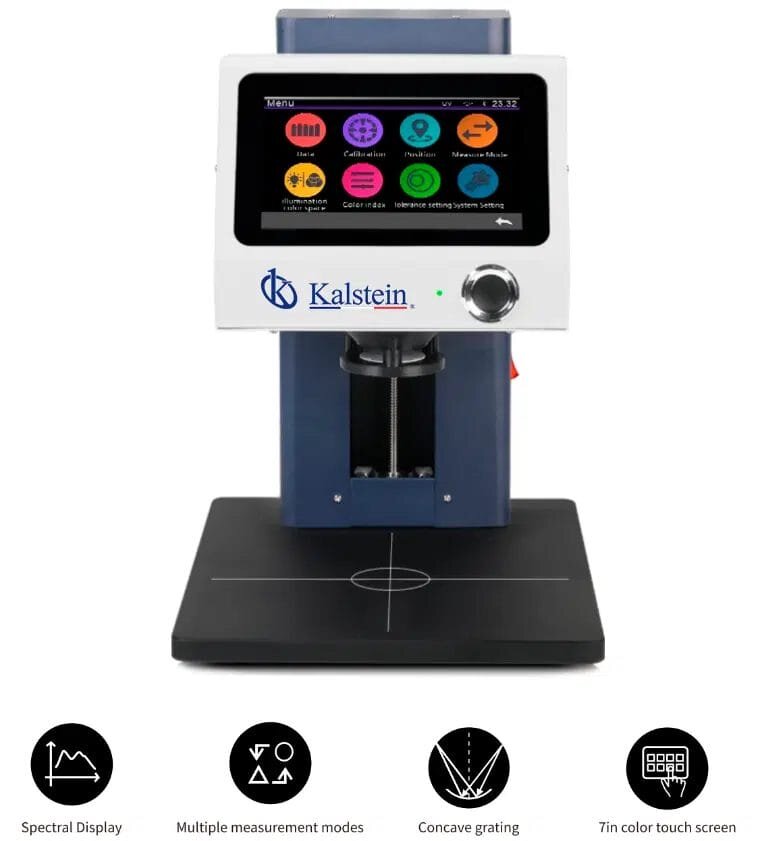In the world of laboratory equipment, spectrophotometers hold a prominent place due to their ability to measure the absorbance and transmittance of light in liquid samples. These instruments are essential in various fields, from biomedical research to the chemical industry. In this guide, we will explore everything you need to know to choose the right spectrophotometer for your laboratory.
If you want to explore the high-end product catalog we have for you at KALSTEIN, visit us at https://kalstein.pk/category-product/laboratory-line/spectrophotometers-laboratory-line/. We assure you that through our easy and feasible online purchasing channels, you will find the best prices on the market. Remember, at KALSTEIN, we manufacture high-level laboratory equipment for sale. https://kalstein.pk/
What is a Spectrophotometer and How Does It Work?
A spectrophotometer is a device that measures the amount of light absorbed by a sample at different wavelengths. This equipment uses a beam of light that passes through the sample and a detector that measures the intensity of light before and after it passes through. The difference in intensity translates to absorbance, which can be correlated with the concentration of components in the sample.
The operation of the spectrophotometer is based on the Beer-Lambert law, which relates absorbance to solute concentration. This principle allows for precise quantitative analyses in various applications, such as determining concentrations of proteins, nucleic acids, and chemical compounds.
Types of Spectrophotometers
There are several types of spectrophotometers, each designed for specific applications. The main types include:
UV-Vis Spectrophotometers
UV-Vis spectrophotometers are the most common and measure absorbance in the ultraviolet and visible range of the electromagnetic spectrum. They are widely used in the analysis of biomolecules and organic compounds due to their ability to detect a wide range of concentrations.
Near-Infrared (NIR) Spectrophotometers
NIR spectrophotometers operate in the near-infrared range and are ideal for applications in the food and pharmaceutical industries, where it is crucial to analyze components such as water, fats, and proteins without the need for sample pretreatment.
Fluorescence Spectrophotometers
These spectrophotometers measure the fluorescence emitted by a sample after being excited by a specific wavelength. They are essential tools in molecular biology and clinical chemistry for detecting trace substances.
Key Features to Consider
When choosing a spectrophotometer, it is crucial to evaluate various features that will determine its suitability for your specific needs. Here are the most important ones:
Spectral Range
The spectral range is the range of wavelengths that the spectrophotometer can measure. UV-Vis models typically cover from 190 to 1100 nm, while NIR models range from 700 to 2500 nm. Ensure that the spectral range of the equipment matches the needs of your analyses.
Resolution
Resolution is the ability of the spectrophotometer to distinguish between two close wavelengths. Higher resolution provides more precise and detailed data, which is crucial in applications requiring a high degree of accuracy.
Precision and Accuracy
Precision refers to the reproducibility of results, while accuracy indicates how close the results are to the true values. It is essential that the spectrophotometer offers high levels of both characteristics to ensure the reliability of analyses.
Comparison of the Best Spectrophotometers on the Market
To facilitate your purchase decision, we have prepared a comparative table of some of the best spectrophotometers available on the market, including standout models from Kalstein and other competitors.
|
Model |
Spectral Range (nm) |
Resolution (nm) |
Precision |
Additional Features |
|
Kalstein UV-1900 |
190-1100 |
1 |
±0.3% |
Intuitive interface, multicomponent analysis, automatic calibration |
|
Thermo Scientific Evolution 300 |
190-1100 |
1 |
±0.3% |
Dual detection technology, easy software integration |
|
Agilent Cary 60 |
190-1100 |
1.5 |
±0.2% |
High scan speed, xenon lamp technology |
|
Shimadzu UV-2600 |
185-1400 |
1 |
±0.3% |
Wide spectral range, low noise level |
|
PerkinElmer Lambda 35 |
190-1100 |
1 |
±0.3% |
Multiple sample capacity, advanced software options |
Tips for Buying Spectrophotometers
When considering the purchase of a spectrophotometer, it is crucial to consider several additional factors that can influence your final decision.
Software Compatibility
The compatibility of the spectrophotometer with analysis software is vital to ensure smooth integration into your workflows. Look for models that offer advanced software options for data manipulation and analysis.
Maintenance and Technical Support
Good technical support and maintenance options are essential to ensure the longevity and continuous performance of the spectrophotometer. Ensure that the manufacturer offers reliable technical service and easy access to spare parts.
Cost-Benefit Ratio
While price is an important factor, the cost-benefit ratio should be a key consideration. Opt for a spectrophotometer that offers a balance between cost, features, and performance to get the best value for your investment.
Choosing the right spectrophotometer can seem like a daunting task due to the wide variety of options available on the market. However, by understanding the different features and types of spectrophotometers, and by carefully considering your specific needs and the technical support offered by manufacturers, you can make an informed decision that will benefit your laboratory in the long term.
Whether you need a spectrophotometer for basic UV-Vis analysis, advanced NIR applications, or fluorescence detection, there are high-quality options that can meet your requirements. The standout models in our comparative table, including Kalstein’s spectrophotometers, offer an excellent combination of precision, resolution, and additional features that make them ideal for a variety of laboratory applications.

